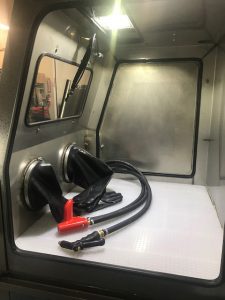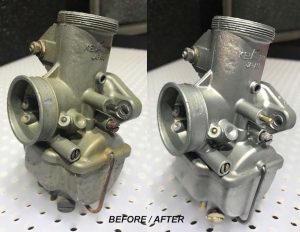Vapor blasting is also commonly known as wet blasting, liquid honing, vapor honing, dustless blasting, or slurry blasting.

Wet blasting (vapor blasting) is a process for removing contaminants from a surface, or finishing a surface using pressurized water and abrasive blast media.
If the abrasive media is mixed with water and pressurized in a pressure pot before being propelled through a blast nozzle and mixed with compressed air. This process is generally known as slurry blasting. (The mix of blast media and water is called a slurry).
Advantages of Wet Blasting
The biggest advantage of wet blasting is it produces a finer finish on a surface than traditional dry blasting. The water flushes out the abrasive, so there is no impregnation of the blasted surface. Any sediment or residual abrasive media is washed out. This leaves a cleaner surface.
Vapor blasting is preferred when you have a surface that you would like to preserve. By using a slurry blaster or vapor blasting cabinet, you can clean, de-grease, and blast a surface in one step. This save considerable time over traditional dry abrasive blasting.
Additionally, you can use much finer abrasive media with wet blasting, as the water is a more effective conduit for fine mesh abrasives than compressed air.
Differences Between Vapor Blasting and Dry Blasting
Vapor blasting is generally much gentler than dry abrasive blasting. The water acts as a cushion for the abrasive. In traditional dry sandblasting, the abrasive impacts the surface, and subsequently shatters into smaller particles, causing dust.
In wet blasting, the water acts as a dampener. When the abrasive hits the blasted surface, the shattered particles are contained within the water. The spent media is collected in a drain basin or other receptacle.
There is another notable difference between dry blasting and vapor blasting. In dry blasting, the abrasive impacts at an angle, leaving a deep anchor profile. In wet blasting, the water cushions the impact, meaning the surface profile is dispersed more evenly, in a feathered pattern. This allows for a finer blasting process.
How Vapor Blasting Works
In outdoor dustless blasting, the abrasive is usually propelled using compressed air. A second hose will either introduce water at the blast nozzle (water injection), or make a halo of water that suppresses some of the dust created by blasting (water ring or water halo).
In a slurry blast cabinet, water and abrasive media is mixed together in a pressurized container, then propelled at an object inside the enclosure. This is effective for cleaning or stripping items like engine parts or aluminum wheels.
Some outdoor dustless blasting units combine the water and abrasive together in a slurry, and this mix is pressurized in a vessel, using either compressed air or water to create the pressure. Then, the slurry is injected into the air flow of the blast hose.
Abrasive Media That Can Be Used in Dustless Blasting
Any type of blast media can be used, though glass beads, or a mix of sodium bicarbonate and fine glass beads are normally used for wet blasting inside a blast cabinet.
For outdoor wet blasting, crushed glass, Green Diamond nickel slag, or copper slag may be used.
Practical Applications for Wet Blasting
Wet blasting lends itself to a wide variety of uses.
Automotive / Motorcycles

Vapor blasting is a natural choice for cleaning grease, rust, factory coatings, or other contaminants from old auto or motorcycle parts. The cleaning and stripping process goes quickly with wet blasting, and the finish is much softer. Aluminum, chrome, or steel surfaces have a satin-like finish at the end of the process.
Industrial Applications for Vapor Blasting
In dry sandblasting, when the abrasive slams into the blasted surface, the abrasive particles split into smaller particulates and dust. This abrasive dust carries a static electric charge, which can create dry sparks. If you are sandblasting around flammable gases or materials, this presents a fire or explosion hazard.
With wet dustless blasting, there is still a small possibility of sparks with the dust particles. However, they are cold sparks, meaning the possibility of explosion is greatly reduced.
Vapor Blasting Sensitive Surfaces
There are certain jobs where traditional sandblasting is too destructive to the substrate to be practical. Because you can wet blast with a lower PSI, and with softer media, there are times where that is more desirable. These include historical or antique restoration, wood restoration, cleaning up fire damage, and removing graffiti.
Outdoor Construction or Urban Settings
Because of regulations on airborne dust, there are many times when wet blasting is the best choice. The water suppresses most of the dust caused by outdoor abrasive blasting, so dust containment is less of an issue.
Vapor Blasting Soft Metal
Traditional dry blasting cause frictional heat to the blasted surface. For softer metals, this can cause unwanted warping. Wet blasting helps cool the frictional heat from abrasive blasting, making it a better choice for blasting stainless steel or aluminum.
Engineering and Aerospace
Vapor blasting is often used to remove carbon deposits, oxidation, paint, and other contaminants in engineering applications. It is also commonly used in cleaning and peening aerospace parts and surfaces.
History of Wet Blasting
Vapor blasting was first developed in England during World War II. Rolls-Royce pioneered this process to peen and finish the surface of turbine blades before assembly into jet engines.
In 1950, the use of crystalline silica was banned in England, due to sandblasting workers developing silicosis, an irreversible respiratory disease. Later in the 1950s, Norman Ashworth began developing the first wet blasters. This was the dawn of dustless blasting.
In 1966, several European nations followed England’s lead, and banned sandblasting with crystalline silica because of health risks.
Outdoor wet blasting units were developed in Europe in the 1970s through the 1990s. Wet blasting has experienced a resurgence in popularity and innovation throughout the 2000s to the present day.
Today, we are proud to take the baton and continue innovating best-in-class wet blast cabinets and sandblasting equipment.
